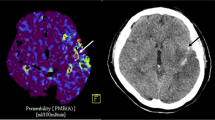Abstract
Objective
The hyperintense acute reperfusion marker (HARM) on fluid-attenuated inversion recovery (FLAIR) images is associated with blood-brain barrier (BBB) permeability changes. The aim of this study was to examine the influence of contrast agent dosage on HARM incidence in acute ischaemic stroke patients.
Methods
We prospectively included 529 acute ischaemic stroke patients (204 females, median age 71 years). Patients underwent a first stroke-MRI within 24 hours from symptom onset and had a follow-up on day 2. The contrast agent Gadobutrol was administered to the patients for perfusion imaging or MR angiography. The total dosage was calculated as ml/kg body weight and ranged between 0.04 and 0.31 mmol/kg on the first examination. The incidence of HARM was evaluated on day 2 FLAIR images.
Results
HARM was detected in 97 patients (18.3 %). HARM incidence increased significantly with increasing dosages of Gadobutrol. Also, HARM positive patients were significantly older. HARM was not an independent predictor of worse clinical outcome, and we did not find an association with increase risk of haemorrhagic transformation.
Conclusions
A higher dosage of Gadobutrol in acute stroke patients on initial MRI is associated with increased HARM incidence on follow-up. MRI studies on BBB should therefore standardize contrast agent dosages.
Key Points
• Hyperintense acute reperfusion marker on MRI indicates blood-brain barrier disruption.
• This observational study on stroke patients characterizes HARM.
• Incidence depends on contrast agent dosage on the previous day.
• HARM is also associated with older age and poor kidney function.
• Interpretation of HARM must take dosage into consideration.


Similar content being viewed by others
Abbreviations
- HARM:
-
Hyperintense acute reperfusion marker
- FLAIR:
-
Fluid-attenuated inversion recovery
- CSF:
-
Cerebrospinal fluid
- BBB:
-
Blood-brain barrier
- DWI:
-
Diffusion-weighted imaging
- PI:
-
Perfusion imaging
- HT:
-
Haemorrhagic transformation
- PH:
-
Parenchymal haemorrhage
- NIHSS:
-
National Institutes of Health Stroke Scale
- mRS:
-
Modified Rankin Scale
- GFR:
-
Glomerular filtration rate
References
Dechambre SD, Duprez T, Grandin CB et al (2000) High signal in cerebrospinal fluid mimicking subarachnoid haemorrhage on FLAIR following acute stroke and intravenous contrast medium. Neuroradiology 42:608–611
Stuckey SL, Goh TD, Heffernan T, Rowan D (2007) Hyperintensity in the subarachnoid space on FLAIR MRI. Am J Roentgenol 189:913–916
Köhrmann M, Struffert T, Frenzel T et al (2012) The hyperintense acute reperfusion marker on fluid-attenuated inversion recovery magnetic resonance imaging is caused by gadolinium in the cerebrospinal fluid. Stroke J Cereb Circ 43:259–261
Ewing JR, Knight RA, Nagaraja TN et al (2003) Patlak plots of Gd-DTPA MRI data yield blood– brain transfer constants concordant with those of 14C-sucrose in areas of blood–brain opening. Magn Reson Med 50:283–292
Warach S, Latour LL (2004) Evidence of reperfusion injury, exacerbated by thrombolytic therapy, in human focal brain ischemia using a novel imaging marker of early blood-brain barrier disruption. Stroke J Cereb Circ 35:2659–2661
Hjort N, Wu O, Ashkanian M et al (2008) MRI detection of early blood-brain barrier disruption - Parenchymal enhancement predicts focal hemorrhagic transformation after thrombolysis. Stroke 39:1025–1028
Latour LL, Kang D-W, Ezzeddine MA et al (2004) Early blood-brain barrier disruption in human focal brain ischemia. Ann Neurol 56:468–477
Rozanski M, Ebinger M, Schmidt WU et al (2010) Hyperintense acute reperfusion marker on FLAIR is not associated with early haemorrhagic transformation in the elderly. Eur Radiol 20:2990–2996
Manka C, Träber F, Gieseke J et al (2005) Three-dimensional dynamic susceptibility-weighted perfusion MR imaging at 3.0 T: feasibility and contrast agent dose. Radiology 234:869–877
Hotter B, Pittl S, Ebinger M et al (2009) Prospective study on the mismatch concept in acute stroke patients within the first 24 h after symptom onset - 1000Plus study. BMC Neurol. doi:10.1186/1471-2377-9-60
Levey AS, Bosch JP, Breyer Lewis J et al (1999) A more accurate method to estimate glomerular filtration rate from serum creatinine: a new prediction equation. Ann Intern Med 130:461–470
Mamourian AC, Hoopes PJ, Lewis LD (2000) Visualization of intravenously administered contrast material in the CSF on fluid-attenuated inversion-recovery MR images: an in vitro and animal- model investigation. AJNR 21:105–111
Acknowledgements
The scientific guarantor of this publication is Jochen B. Fiebach. The authors of this manuscript declare no relationships with any companies, whose products or services may be related to the subject matter of the article. This study has received funding from the Federal Ministry of Education and Research via the Grant Center for Stroke Research Berlin (01EO0801 and 01EO1301). No complex statistical methods were necessary for this paper. Institutional Review Board approval was obtained. Written informed consent was obtained from all patients in this study. Methodology: prospective, observational study, performed at one institution.
Author information
Authors and Affiliations
Corresponding author
Rights and permissions
About this article
Cite this article
Ostwaldt, AC., Rozanski, M., Schaefer, T. et al. Hyperintense acute reperfusion marker is associated with higher contrast agent dosage in acute ischaemic stroke. Eur Radiol 25, 3161–3166 (2015). https://doi.org/10.1007/s00330-015-3749-5
Received:
Revised:
Accepted:
Published:
Issue Date:
DOI: https://doi.org/10.1007/s00330-015-3749-5




